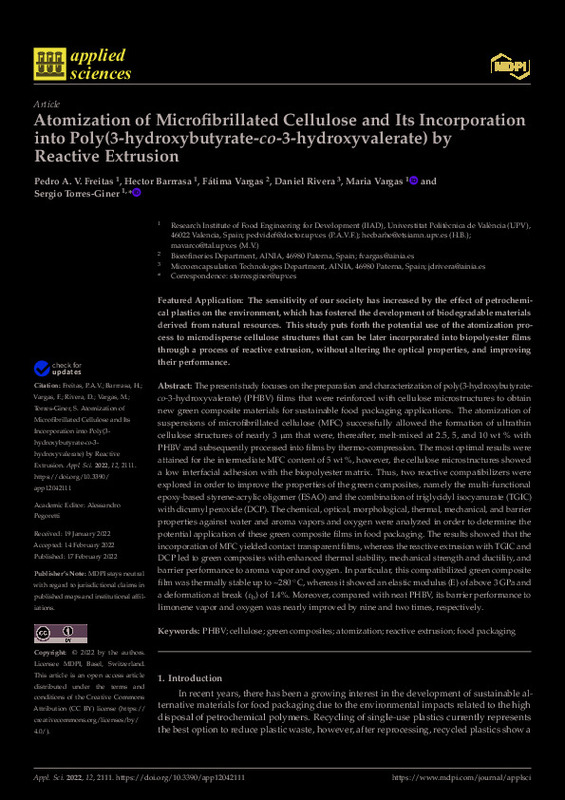JavaScript is disabled for your browser. Some features of this site may not work without it.
Buscar en RiuNet
Listar
Mi cuenta
Estadísticas
Ayuda RiuNet
Admin. UPV
Atomization of Microfibrillated Cellulose and Its Incorporation into Poly(3-hydroxybutyrate-co-3-hydroxyvalerate) by Reactive Extrusion
Mostrar el registro sencillo del ítem
Ficheros en el ítem
| dc.contributor.author | Vieira-De Freitas, Pedro Augusto
|
es_ES |
| dc.contributor.author | Barrasa, Hector
|
es_ES |
| dc.contributor.author | Vargas, Fátima
|
es_ES |
| dc.contributor.author | Rivera, Daniel
|
es_ES |
| dc.contributor.author | Vargas, Maria
|
es_ES |
| dc.contributor.author | Torres-Giner, S.
|
es_ES |
| dc.date.accessioned | 2023-05-22T18:02:29Z | |
| dc.date.available | 2023-05-22T18:02:29Z | |
| dc.date.issued | 2022-02 | es_ES |
| dc.identifier.uri | http://hdl.handle.net/10251/193510 | |
| dc.description.abstract | [EN] The present study focuses on the preparation and characterization of poly(3-hydroxybutyrate-co-3-hydroxyvalerate) (PHBV) films that were reinforced with cellulose microstructures to obtain new green composite materials for sustainable food packaging applications. The atomization of suspensions of microfibrillated cellulose (MFC) successfully allowed the formation of ultrathin cellulose structures of nearly 3 µm that were, thereafter, melt-mixed at 2.5, 5, and 10 wt % with PHBV and subsequently processed into films by thermo-compression. The most optimal results were attained for the intermediate MFC content of 5 wt %, however, the cellulose microstructures showed a low interfacial adhesion with the biopolyester matrix. Thus, two reactive compatibilizers were explored in order to improve the properties of the green composites, namely the multi-functional epoxy-based styrene-acrylic oligomer (ESAO) and the combination of triglycidyl isocyanurate (TGIC) with dicumyl peroxide (DCP). The chemical, optical, morphological, thermal, mechanical, and barrier properties against water and aroma vapors and oxygen were analyzed in order to determine the potential application of these green composite films in food packaging. The results showed that the incorporation of MFC yielded contact transparent films, whereas the reactive extrusion with TGIC and DCP led to green composites with enhanced thermal stability, mechanical strength and ductility, and barrier performance to aroma vapor and oxygen. In particular, this compatibilized green composite film was thermally stable up to ~280 °C, whereas it showed an elastic modulus (E) of above 3 GPa and a deformation at break (¿b) of 1.4%. Moreover, compared with neat PHBV, its barrier performance to limonene vapor and oxygen was nearly improved by nine and two times, respectively. | es_ES |
| dc.description.sponsorship | This research was funded by Spanish Ministry of Science and Innovation (MICI), grant numbers PID2019-105207RB-I00 and RTC2019-007268-2. | es_ES |
| dc.language | Inglés | es_ES |
| dc.publisher | MDPI AG | es_ES |
| dc.relation.ispartof | Applied Sciences | es_ES |
| dc.rights | Reconocimiento (by) | es_ES |
| dc.subject | PHBV | es_ES |
| dc.subject | Cellulose | es_ES |
| dc.subject | Green composites | es_ES |
| dc.subject | Atomization | es_ES |
| dc.subject | Reactive extrusion | es_ES |
| dc.subject | Food packaging | es_ES |
| dc.subject.classification | TECNOLOGIA DE ALIMENTOS | es_ES |
| dc.title | Atomization of Microfibrillated Cellulose and Its Incorporation into Poly(3-hydroxybutyrate-co-3-hydroxyvalerate) by Reactive Extrusion | es_ES |
| dc.type | Artículo | es_ES |
| dc.identifier.doi | 10.3390/app12042111 | es_ES |
| dc.relation.projectID | info:eu-repo/grantAgreement/AEI/Plan Estatal de Investigación Científica y Técnica y de Innovación 2017-2020/PID2019-105207RB-I00/ES/USO DE ACIDOS FENOLICOS PARA LA OBTENCION DE MATERIALES MULTICAPA ACTIVOS PARA EL ENVASADO DE ALIMENTOS/ | es_ES |
| dc.relation.projectID | info:eu-repo/grantAgreement/AGENCIA ESTATAL DE INVESTIGACION//RYC2019-027784-I//AYUDA CONTRATO RAMON Y CAJAL-TORRES GINER/ | es_ES |
| dc.relation.projectID | info:eu-repo/grantAgreement/MICINN//RTC2019-007268-2/ | es_ES |
| dc.rights.accessRights | Abierto | es_ES |
| dc.contributor.affiliation | Universitat Politècnica de València. Instituto Universitario de Ingeniería de Alimentos para el Desarrollo - Institut Universitari d'Enginyeria d'Aliments per al Desenvolupament | es_ES |
| dc.contributor.affiliation | Universitat Politècnica de València. Escuela Técnica Superior de Ingeniería Agronómica y del Medio Natural - Escola Tècnica Superior d'Enginyeria Agronòmica i del Medi Natural | es_ES |
| dc.description.bibliographicCitation | Vieira-De Freitas, PA.; Barrasa, H.; Vargas, F.; Rivera, D.; Vargas, M.; Torres-Giner, S. (2022). Atomization of Microfibrillated Cellulose and Its Incorporation into Poly(3-hydroxybutyrate-co-3-hydroxyvalerate) by Reactive Extrusion. Applied Sciences. 12(4):1-27. https://doi.org/10.3390/app12042111 | es_ES |
| dc.description.accrualMethod | S | es_ES |
| dc.relation.publisherversion | https://doi.org/10.3390/app12042111 | es_ES |
| dc.description.upvformatpinicio | 1 | es_ES |
| dc.description.upvformatpfin | 27 | es_ES |
| dc.type.version | info:eu-repo/semantics/publishedVersion | es_ES |
| dc.description.volume | 12 | es_ES |
| dc.description.issue | 4 | es_ES |
| dc.identifier.eissn | 2076-3417 | es_ES |
| dc.relation.pasarela | S\455970 | es_ES |
| dc.contributor.funder | AGENCIA ESTATAL DE INVESTIGACION | es_ES |
| dc.contributor.funder | Agencia Estatal de Investigación | es_ES |
| dc.contributor.funder | Ministerio de Ciencia e Innovación | es_ES |
| dc.subject.ods | 12.- Garantizar las pautas de consumo y de producción sostenibles | es_ES |








